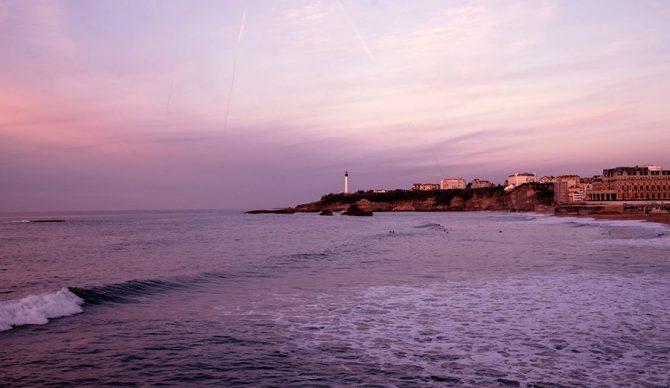
Riding by rail? Plan accordingly. Photo: Lusija Ros//Unsplash
“What do you mean we can’t get on with the board bag? We’ve been on a dozen trains with it in the last month!” I asked frantically.
I was becoming increasingly irate with the station employee. We’d been arguing for ten minutes, switching between Spanish and English whenever I needed a new adjective to describe the absurdity of the situation. After all, I’d come by yesterday to reserve my seat and asked in both languages whether surfboards were permitted on the train. I stormed off towards the ticket window to express my complete contempt for the station employee barring me from boarding the train I needed to catch to make my flight home.
Alas, the ticket window employees were no help. They sat behind their protective aquarium glass while I proceeded to tear my tickets in what I then thought was a brazen act of defiance but most nearly resembled a temper tantrum. It was barely 7 a.m. on a crisp January morning in San Sebastian, Spain. Rain was falling outside from a melancholy winter sky, and the sun had yet to rise. The train from San Sebastian to Barcelona ran once a day at that time, and there was no getting around this apparent anti-surfboard policy. As I was in the throes of near mental collapse, my girlfriend was calmingly researching an alternative route to Barcelona and locating a rental car office that would open by eight. Surf tripping Europe by train is entirely possible (and amazing). But maybe let my follies inform your journey. It’ll be a whole lot smoother.
Pack Intentionally
Months earlier, when I was planning my January trip to Europe with my girlfriend, I debated whether I should bring a board at all. I’d reassured her, time and again, that this was not a surf trip, and I wasn’t commandeering our trip together. Instead, if we happened upon good surf in Biarritz or San Sebastian, I’d be prepared and not have to search for a quality rental amongst the soft-tops and longboards available along the beach.
I consulted friends in France and Portugal who assured me traveling by train with a surfboard was doable. They informed me that I needed to look up the policies of each carrier, and I should only bring one board. I chose a utilitarian 5’8” swallow tail as a one-board quiver and packed it with care in a slim day bag. I padded the rails with pipe insulator, put a protective layer of cardboard around the swallowtail, guarded the nose with my wetsuit, and bubble wrapped the whole thing in my day bag — the works. Days before we left, I contacted my friend Sunny Fassler, who lives in San Sebastian and works for Luex, a European-based surf travel company. Sunny had just traveled to San Sebastian from Barcelona on the same train I was planning to take, so I reached out, and his response gave me pause.
“I traveled by train to San Sebastian from Barcelona once, and it was a fucking pain”

And with views like these….. Photo: Morgan Bernard
Do Your Research
After finding little evidence online to support either claim, I decided to risk it. Each country in Europe has its own railway carriers, and each carrier has its own surfboard policy. When choosing carriers, you can look up their sporting equipment policies on their website. If you’re having trouble finding info, a good rule of thumb is to always choose the larger carrier and the larger train. In France, I had no issues while traveling on Thalys, but on SNCF, I was forced to pay a €50 fee. Larger trains have larger luggage compartments, so you can lay your board bag on top of other suitcases in the luggage compartment. If your board is small enough, it may even fit in the overhead compartment. Smaller trains lack the same lengthy luggage carts, so it’s unlikely you’ll find a place for your board other than in the hallway.
Plan Your Route by Carrier
If you’re traveling between small towns and the only train option is a smaller carrier or smaller train, consider taking a bus. Busses will always allow surfboards. If you’re using a Eurail Pass, you have access to a selection of bus carriers. Like booking a train with your pass, you still need to make a reservation online or at the station prior to your departure. A Eurail pass isn’t always the most affordable way to travel, but if you’re traveling predominately by rail, you’ll save big. My pass allowed me 10-days of train travel within a 30-day window for under $300. I only had to pay the small fee to reserve my ticket, not the full fare.

The sweet rewards for shuffling station to station. Photo: Morgan Bernard
And the Surfing…..Wish You Were Here….
The pain of lugging a board bag from train station to train station and up and down cobblestone-lined hills washed away with my first surf in Biarritz. A cruisy right point wrapped around the cliffy coast and sent head-high runners towards the shore. The water was a balmy 55 degrees, but the sun was shining high in the winter sky. All along the coast, locals were enjoying the rare reprieve from the typical gray winter day. Surfers bobbed up and down at various breaks around town while swimmers braved the icy water sans neoprene. Along the shore, kids played, dogs chased each other, and tourists oohed and aahed at the spectacle of waves lapping against a jagged coastline, all before a mix of Neo-Basque and Art Deco architecture.
Had I been more thorough with my planning, I could have avoided the small rail line in San Sebastian by changing the order of my travel or flying directly there. Instead of traveling by rail to Barcelona, we drove along winding mountain roads towards snowcapped peaks in the Pyrenees before making our way south to Barcelona. While the trip wasn’t the smoothest travel experience, it showed me that rail travel with a surfboard is not only possible but enjoyable. As long as you stick to larger rail companies, do your research, and pack considerately, you’re in for the trip of a lifetime.

